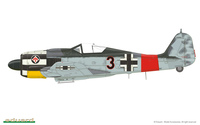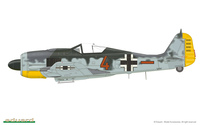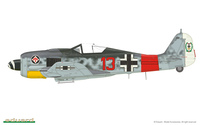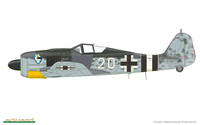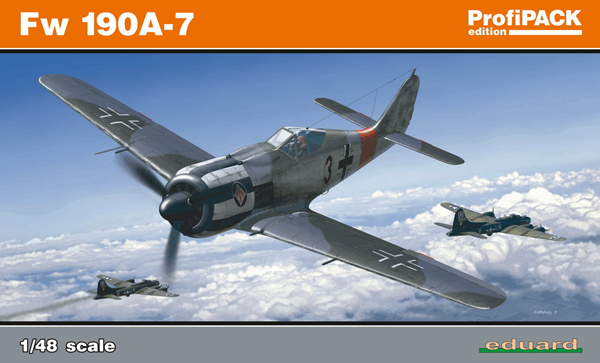
Eduard 1/48 Fw190A-7 Profipack Edition
By Winston Gould
Introduction
From Eduard Web Site for Fw190A-7 (Kit # 8172):
Fw 190A-7 kit in the ProfiPACK edition covers a missing link in the Eduard Fw 190A family. Correct solution of panel lines for that version, supported by various kit accessories offers an accurate reproduction of the A-7 variant.
Fw190A-7 (From the instructions for the kit):
The second half of the Second World War saw the Focke-Wulf Fw190, in its various forms, emerge as the best of what was available to the Luftwaffe. The dedicated fighter version was a high performance, heavily armed machine. Its development had a precarious beginning, against a 1938 specification issued by the Technishes Amt, RLM. The first prototype took to the air on June 1, 1939.
After a series of improvements and even radical changes, the design culminated in the fall of 1940 in the pre-series version Fw190A-0 to the tune of twenty-eight pieces. Six of these were retained by the test unit Erprobungsstaffel 190 at Rechlin, which was tasked with conducting service trials. These revealed a wide range of flaws to the point where the RLM halted further development. Despite this, on the basis of urgings from the test unit staff, the aircraft was not shelved.After a series of some fifty modifications, the RLM gave the go ahead for the Fw190 to be taken into inventory of the Luftwaffe. In June, 1941, the Luftwaffe accepted the first of 100 ordered Fw190A-1s, armed with four 7.9mm MG17s. By September, 1941, II/JG 26 was completely equipped with the type, operating on the Western Front. November saw the production of the next version Fw190A-2, powered by a BMW801C-2, and armed with two 7.9mm MG17s and two MG151s of 20mm caliber in the wings.
Part of this series received an additional pair of 20mm MG FFs, thus attaining an armament standard of later types. A significant advancement to the design came in the spring of 1942, when the BMW801D-2 became available, its installation gave birth to the Fw190A-3.
July saw the development of the improved A-4. Both were armed with what became the standard two fuselage mounted MG17s, two wing mounted MG151 cannon, and two MG FF cannon, placed inboard of the wheel wells.During 1942, production had intensified, and a production facility was set up under license at Fieseler. Thanks in part to this, production rose in 1942 to 1,878 units as opposed to 224 in 1941.
Large-scale production of the A-5 was initiated in April, 1943, with an identical wing to the A-4, but with a nose extension that would become standard on all subsequent Fw-190A versions up to the A-9, and also on the corresponding F types. July saw the development of a new, strengthened wing, which incorporated MG151s instead of the MG FFs in the outer position. The adoption of this wing developed the A-6 version.
Further changes developed the A-7, produced during the end of 1943. This version came about with the replacement of the fuselage mounted MG17s with 13mm MG131s.Additional improvements led to the Fw190A-8, and this version became the most widely produced with some 1400 units made. The most significant change to this variant was the installation of the GM-1 nitrous-oxide injection system, for temporary power boost in combat. A portion of A-8 production was built as the A-8/R2 and A-8/R8, armed with MK108 cannon in the outer wing location, and with armoured slabs added to the cockpit sides and a modified canopy.
The final production version of the BMW801 powered fighter was the Fw190A-9, equipped with the BMW801TS of 2000hp (1470kW).
There was a parallel development of these fighter optimized aircraft with a dedicated fighter-bomber version, the Fw190F. These aircraft had reduced wing armament to two MG151 cannon in the wingroot position. The engine was optimized for low level operation, and the armament options varied to satisfy the ground attack role, including bombs of various weight classes and a variety of anti-tank rockets. This branched into the extended range Fw190G version.
Development of the thoroughbred fighter continued in the guise of the Fw190D, which began to reach Luftwaffe units in the second half of 1944, and was the result of mounting an in-line Jumo213A-1 engine into a modified Fw190A-8 airframe.Although the Fw190 never achieved the widespread usage of the competing Bf109, its contribution to the German Air Force was certainly significant through the second half of WWII. Fw190s saw service on the Western Front as well as in the East. As heavy fighters with imposing firepower, they found themselves integral components, from 1943 onwards, within the units tasked with the protection of the Reich from the ominous clouds of allied four-engined bombers. This is where the A-8 version was instrumental, along with its A-8/R2 armoured development.
This version, with its firepower, was a very ominous and daunting foe for the bomber crews. From the second half of 1944, their danger was kept in check to a degree by escorting P-47s, and necessitated the development of the P-51 Mustang.
The Kit:
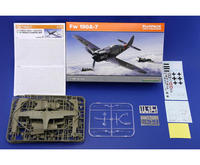
|
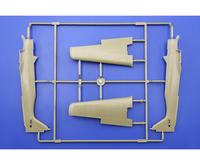
|
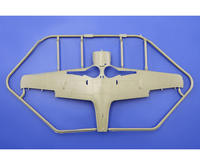
|
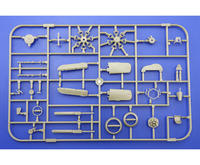
|
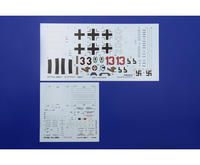
|
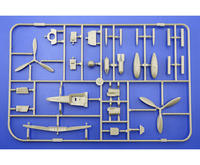
|
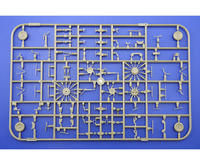
|
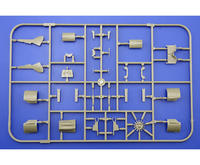
|
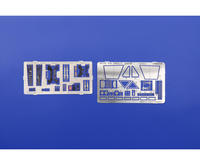
|
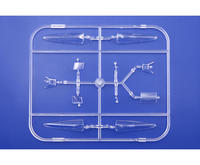
|
The kit comes in a top-opening box containing seven sprues (Six in tan-colored plastic, one clear plastic). Four decal options are offered, all German aircraft from 1944. This ProfiPACK edition kit is the standard Eduard ProfiPACK offering, with multiple markings, photoetch cockpit and exterior details and masks. The included photo-etched accessories allow you to build the armored Fw190-A-7/R2 version. The Germans modified the basic aircraft through Rustsatz (Field Conversion kits). Rustsatz could be armament options, additional armor or a combination of modifications. The Fw190A-7/R2 designates the exterior armor added to provide more protection for the pilot.
The surface detail is nice with a smooth finish, engraved panel lines and raised detail as appropriate for the aircraft. The sixteen-page instruction sheet is a black and white, A4 sheet folded in half. The painting reference pages for the included markings are in color with the last page showing stencil data.
Fw190A-7 markings in kit:
- W.Nr. 430352, 2. /JG 1, Dortmund Airfield, Germany, January, 1944
- W.Nr. 340001, flown by Oblt. Waldemar Radener, CO of 7./JG 26, Cambrai-Süd Air Base, France, May, 1944
- W.Nr. 431007, flown by Heinz Bär, CO of II./JG 1, Störmede Air Base, Germany, April, 1944
- W.Nr. 642962, flown by Maj. Hans-Günther von Kornatzki, CO of Sturmstaffel 1, Salzwedel Air Base, Germany, February, 1944
Construction is shown in 10 packed and very busy steps. Color references are Mr. Color, Mr. Metal Color, Mr. Color Super Metallic and Gunze Aqueous, with the appropriate paint manufacturer reference numbers and names. Reichsluftfahrt Ministerium (State Ministry for Aviation) (RLM) equivalents are listed. I recommend the ‘Twelve O’Clock High’ RLM Reference Web Site for an excellent RLM reference: https://rhorta.home.xs4all.nl/jgrlm.htm.
Assembly starts with a very detailed cockpit – including the photo-etch instrument panel details. The option is provided for raised-detail instrument panel and side consoles if you do not want to use the photo-etch or smooth instrument panel and side consoles for use with the photo-etch. The fuselage is then closed up and the firewall and tail wheel assemblies are added.
The lower wing details are built in the next two steps followed by the upper wing details. The upper wings are added to the lower wings then the completed wing is attached to the fuselage.
The BWM 801 engine is built in the next step (this step is not for the faint hearted) and the engine and cowling mounted to the firewall. If you detail the engine, you will hide all your hard work when you cowl the engine – depends on how much work you want to do. The main landing gear is the next step.
The last step includes the canopy, optional drop tank and cowl-mounted cover for the cannons. That’s it for construction. Paint and decal per the instructions (the four schemes are the same basic camouflage with some nice markings to choose from) and you have a sharp-looking Fw190A-7. The most colorful version is Option A, W.Nr. 430352, 2. /JG 1, Dortmund Airfield, Germany, January, 1944. However, my favorite (and the one I will build) is Option C, W.Nr. 431007, flown by Heinz Bär, CO of II./JG 1, Störmede Air Base, Germany, April, 1944. I like the colorful unit markings and the white tail with his unique Victory ‘Kill’ markings.
Conclusion:
This kit is exactly what Eduard advertises for its ‘ProfiPACK Edition’ kits: Multiple versions with the main kit in plastic, etched cockpit details, masks and a comprehensive instruction sheet. You do get plenty of external stores for the spares box. Watch Internet Modeler for a full build review in the Fall. Highly recommended, especially if you want to build a quality out-of-the-box Fw190A-7. Thank you Eduard for providing the review sample.

